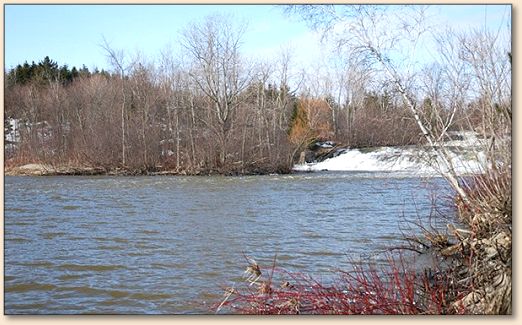Reading the Water - Part 2
(Pools)
By Chris Chin
Back to some fish biology: I have noticed that where water is
flowing through riffles and runs, a trout will set up on a station.
The biggest often get the best lies. Some serious shoulder rubbing
sometimes takes place to keep these spots. When the current slows
down and the water deepens, trout seem to be more susceptible to
start schooling. They seem to tolerate more close company.
Depending on the size of your waters, a pool can be anything
from a pocket a few yards long to a monstrosity that seems
more like a small lake hundreds of yards long. No matter what
the size of the pool in your playground, they all have a few similar
characteristics. A pool will have three distinct sections: a head
(where the current flows in), a main body with some serious
depth and a tail out.

The pool in my back yard.
The head is the base of the falls and the tail out starts 700 feet downstream.
Going back to thinking like a trout, where would you (and
your friends) hangout? Remember, you want protective
cover from predation, hydraulic effects to not waste energy
holding station and food arriving.
In my humble opinion, any of the three parts of a pool will
hold trout, depending on the situation.
When there is active "bug" activity upstream in the run from
the pool, a trout would like to be at the head of the pool
waiting for goodies to tumble into the pool. The same goes
for the tail out. When there is little activity, I often find trout
milling about in the body of the pool. Then there are those
magic moments when an emergence takes place IN the body
of the pool and there is active feeding right in the main pool.
One aspect of fly fishing that many folks neglect when fishing
a big pool is a long dead drifted dry. It will always amaze me
how curious a trout can be. On one of the bigger pools on my
home waters, I will often try a dead drifting Red Tag dead
center in the pool. With a long leader, Iíll often let the fly drift
lazily for 5 or even 10 minutes. In other words, a big pool can
be fished exactly like still water, except that itís much easier to
guess where the fish could be hiding!
In the deepest and darkest part of a pool, there are all manner
of bugs living in the depths. A slow retrieve through the body
of a pool is a fine way to see if a lunker would like to gobble
up a #6 woolly bugger. I prefer a figure 8 retrieve on deep pools
because I can keep constant tension on the line to feel the must
subtle take. Remember, in the slow moving waters of a pool, the
trout can lazily cruise by an offering, give it a taste and spit it back
out rather than dashing out and grabbing it. (just as Bows will
sip on subsurface nymphs on the Kamloops Interior plateau.)
Lastly, a pool is (again, IMHO) one of the most serene and
peaceful places on a river. Feeding activity can be the gentlest
of movements just under the surface. Take the time to observe
and examine a pool upon arrival. The trout can be holding
anywhere in a pool!

Looking for rises on the #3
~ Chris Chin, St-Severin de Proulxville, Quebec.
About Chris:
Chris Chin is originally from Kamloops,
British Columbia. He has been fly fishing
on and off ever since he was 10 years old.
Chris became serious about the sport within
the last 10 years.
"I'm a forest engineer by day and part time
guide on the Ste-Marguerite River here in
central Quebec. I've been fishing this river
for about 10 years now and started guiding
about 5 years ago when the local guide's
association sort of stopped functioning."
Chris guides mostly for sea run brook trout
and about 30% of the time for Atlantic Salmon.
"I often don't even charge service fees, as
I'm more interested in promoting the river
than making cash. I like to get new comers
to realize that salmon fishing is REALLY for
anyone who cares to try it. Tradition around
here makes some of the old clan see Salmon
fishing as a sport for the rich. Today our
shore lunches are less on the cucumber sandwich
side and more toward chicken pot pie and Jack
Daniel's."
Chris is 44 years old as of this writing. He
is of Chinese origin although his parents were
born and raised in Jamaica.
To learn more about the Ste-Marguerite River,
visit Christopher's
website. You can email Chis at: Flyfishing.christopher@gmail.com.
Our Man In Canada Archives
|

